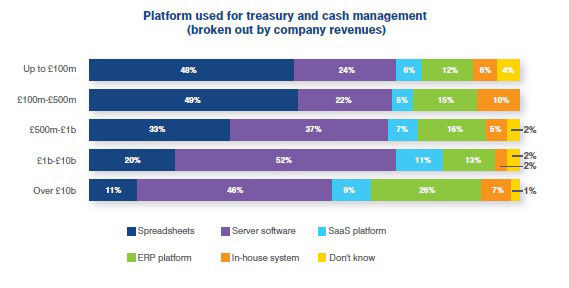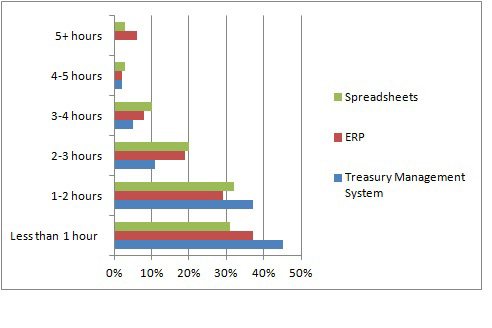A recent survey by Kyriba of members of the Association of Corporate Treasurers (ACT) provides statistical confirmation of something finance executives have known for years: Spreadsheets are not the most efficient tool for managing the treasury function.
The vast majority of the survey's 269 respondents, mostly from the U.K. and Ireland, engage in operational cash management (78 percent) and in cash position reporting and forecasting (75 percent) on a daily basis. Many also engage in risk management (66 percent); providing data for corporate decisions (58 percent); and high-level, strategic financial analysis (43 percent) from day to day.
Nevertheless, 48 percent of companies with less than £100 million in annual revenue use spreadsheets to complete their daily cash management activities. Even among companies with more than £10 billion in revenue, 11 percent use spreadsheets for cash management, while 46 percent use a client-server-based treasury management system, 9 percent use a software-as-a-service treasury management system, 26 percent use their ERP system, and 7 percent use a system developed in-house (see graph below).

The Kyriba survey also found that the type of platform a company uses for treasury and cash management has a noticeable impact on the treasury department's productivity. When asked how much time they spend each day on manual/operational tasks, such as generating accounting entries or gathering bank information, 38 percent of respondents indicated that they spend less than an hour, and only 12 percent spend more than three hours per day.
However, among respondents who use spreadsheets for day-to-day treasury operations, only 31 percent spend an hour or less on manual tasks, whereas 17 percent spend more than three hours on them. Among those who use a treasury management system platform, manual activities take less than an hour for 45 percent of respondents and take more than three hours for only 6 percent. The numbers for enterprise resource planning (ERP) users fall between those for treasury management systems and spreadsheet users. (See graph below.)
Looking at the data another way, respondents using spreadsheets for day-to-day cash management spend an average of 1.8 hours per day on manual and operational tasks, compared with 1.3 hours per day for respondents using a treasury management system. The half-hour saved each day translates into more than three weeks per year that these users presumably can dedicate to more strategic tasks.
Time Per Day Spent on Manual/Operational Tasks

© Touchpoint Markets, All Rights Reserved. Request academic re-use from www.copyright.com. All other uses, submit a request to [email protected]. For more inforrmation visit Asset & Logo Licensing.



